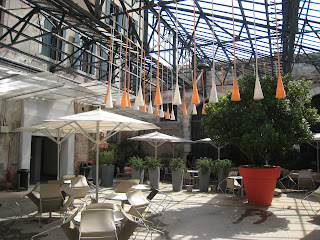First off was the Portuguese Pavilion with an exhibition beguiling entitled Experiments and Observations on Different Types of Air. The exhibition is aptly described in documentation as "poetry as a possible means of capturing an only partially discernible world". Walking in from the bright sunlight, one was immediately disoriented by the pitch darkness. Several inter-leading rooms featured 16 films running on mechanical projectors. Each film featured a slowly unfolding phenomenon involving one of water, air, earth or fire. The stillness, the clacking of the projector, the quality of the film stock and the subtlety of the observations were transporting.

From here, Boxo headed to the Palazzo Grassi - one of two homes Fancois Pinault has created for his mega-collection. The Punta della Dogana, which opened ceremoniously a couple of days beforehand, is the other. They were advertising a show titled 'Mapping the Studio' in a nod to Bruce Nauman. After following the strict directional signage, and viewing a mix of luxuriously hung luxury items, quite what was meant by the title was entirely lost. No curatorial statement or guidance whatsoever. Rather, a marketing tagline to give these institutions a place in the current proceedings. A visit to the Dogana later in the day confirmed this thought. More of the same and a guard who proclaimed that photos were for those with authorization and not for "normal people". Both buildings have been beautifully renovated to the purpose by Tadao Ando, and the coffee at the cafe was kick ass. Go Francois!
Next on to the two sites of the collateral exhibitions of Nauman's work being shown university facilities. These are where the pieces Nauman made for the Biennale are housed. The first stop at the Universita Ca' Foscari, featured the sound piece titled Giorni. The piece featured a long hall of flat panel speakers from which the days of the week read in Italian by a several different voices were emitted at irregular intervals. One could walk the length between the speakers and experience a wave of rhythmic perception or sit on a tall stool and hear a pair of readers converge and part, converge and part.
Nearby, was a site specific piece, Untitled. This is a video work in which two women lithely swing their way around in a circular motion, over a grid taped on the floor. The grid is still physically in place, with the video projected on top of it. Several other older pieces were also installed, including Double Steel Cage Piece, one steel cage housed within another. A young woman had slid into the narrow space between the cages, a space calculated to discourage most folks from making an attempt.


A short walk away, at Tolentini, lunch beckoned before the second Nauman installation was explored. This installation was composed mostly of sound pieces, including an English version of the new sound work, entitled Days.

Now there was only one major item left on the checklist: Peter Greenaway's work on the island of San Giorgio. On the way to catch the long vaporetto from Roma to San Marco, Boxo glimpsed the new Calatrava bridge, another graceful triumph of engineering.


Greenaway's work, The Wedding at Canna, is part of a series of works titled Nine Classic Paintings. In this series, Greenaway is reinterpreting classic works using pioneering technologies. The Wedding at Canna, a huge painting depicting Christ turning water into wine, was painted by Veronese in 1562/1563. It was later cut up into pieces and sent to Paris as part of a war reparation agreement. Recently, a digital recreation of the piece was painstakingly created and hung back in the place of the original. Greenaway brings the piece to life in a wonderful display of sound, light and video. This was an uplifting way to end a long, and sometimes daunting, art adventure.



That evening, Boxo was hosted by new friends Roman Sadnik, an opera singer, and his partner Gille Gubelmann, a visual artist and scenic designer for opera. They now occupy a large Venetian palazzo-style apartment which Gille has renovated most artfully. Some of the rooms are available on a b&b basis and Boxo highly recommends this stylish base for Biennales, Carnivales and all other Venetian exploits.

The review of this year's Biennale are mostly negative, filled with accusations of mediocrity and banality as well as historicism. To a first time participant, the luxury of this much work and the generosity of the countless government and cultural institutions in creating the pavilions and collateral exhibitions, is exciting and praiseworthy. While stimulating pieces and concepts were few and far between, they afforded a sense of discovery and delight. Boxo is thankful to the Secretariat of the Biennale for inviting BoxoFFICE to the previews and looks forward to future participation, including the 2019 repair of the clay pot with Yoko Ono.






























































